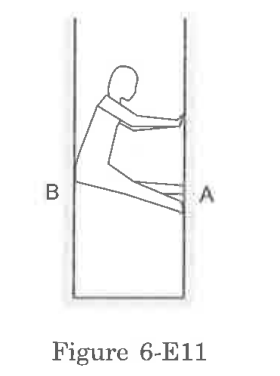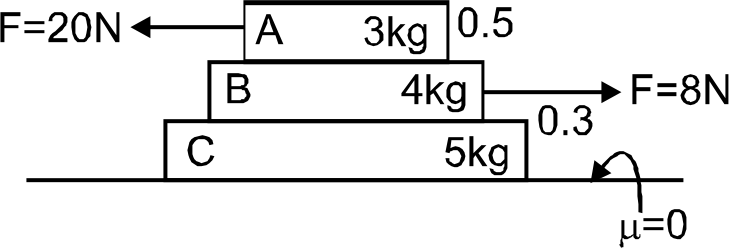A rock-climber (49 kg) is managing to be at rest between two vertical rocks pressing one rock A by his feet and the other B by his back . If the coefficient of friction between his shoes and wall is A 1.2 while between his back and wall B is 0.8 and limiting friction acts at all the contacts , then : (a) What is his push against the rock ? (b) What percent of the weight is supported by the frictional force an legs ?

The correct Answer is:(a) 240 N , (b) 60%
(a) as NA=NB
Now μANA+μBNB=Mg
NA[μA+μB]=Mg
NA=MgμA+μB
(b) fA=μANA
Now present of weight supported by it is
=μANAMg×100
Topper's Solved these Questions
- FRICTION AND CIRCULAR MOTION Book:GRB PUBLICATIONChapter:FRICTION AND CIRCULAR MOTION Exercise:OBJECTIVE QUESTIONS ( only one choice is correct )
Explore 80 Videos
- FRICTION AND CIRCULAR MOTION Book:GRB PUBLICATIONChapter:FRICTION AND CIRCULAR MOTION Exercise:More than one correct
Explore 18 Videos
- FRICTION AND CIRCULAR MOTION Book:GRB PUBLICATIONChapter:FRICTION AND CIRCULAR MOTION Exercise:Comprehension type
Explore 11 Videos
- FORCE AND NEWTONS LAWS OF MOTIONBook:GRB PUBLICATIONChapter:FORCE AND NEWTONS LAWS OF MOTIONExercise:Comprehension
Explore 12 Videos
- MOTION IN A STRAIGHT LINEBook:GRB PUBLICATIONChapter:MOTION IN A STRAIGHT LINEExercise:Comprehension type Queston
Explore 14 Videos
Similar Questions
A person (40 kg) is managing to be at rest between two verticle walls by pressing one wall A by hi hands and feet and the other wall B by his back figure. Assume that the friction coefficient between his body and the walls is 0.8 and that limiting friction acts at all the contacts. a. show that the person pushes the two walls with equal force. b. find the normal force exerted by either wall on the person Take g=10ms2.

View SolutionIn the situation shown coefficient of friction between A and B is 0.5 and between B and C is 0.3 . Friction acting between B and C is xN then 9x7 is

View Solution
Knowledge Check
What is the angle of friction, if the coefficient of friction between two surfaces is 0.25 ?
Aθ=sin−1(1√17)Bθ=cos−1(1√17)Cθ=tan−1(0.5)Dθ=cot−1(2)The coefficient of friction between two surface is 0.2. The maximum angle of friction is
Asin−1(0.2)Bcos−1(0.2)Ctan−1(0.1)Dcot−1(5)If coefficient of friction between both the block is μ−12 . Find friction force acting between both block.
 A16NB20NC8ND10N
A16NB20NC8ND10N
Differentiate between rocks and minerals.
View SolutionA block of mass 1kg is pressed against a wall by applying a horizontal force of 10N on the block. If the coefficient of friction between the block and the wall is 0.5 ,magnitude of the frictional force acting on the block is
View SolutionA man of mass 40kg is at rest between the walls as shown in the If '●' between the man and the walls is 0.8 find the normal reactions exerted by the walls on the man .
View SolutionA block of mass 0.1 kg is held against a wall by applying a horizontal force of 5 N on the block. If the coefficient of friction between the block and the wall is 0.5, then the magnitude of the frictional force acting on the block is
View SolutionA block of mass 0.1 is held against a wall applying a horizontal force of 5N on block. If the coefficient of friction between the block and the wall is 0.5, the magnitude of the frictional force acting on the block is:
View Solution
